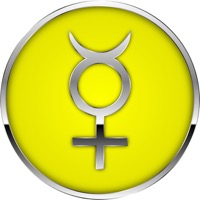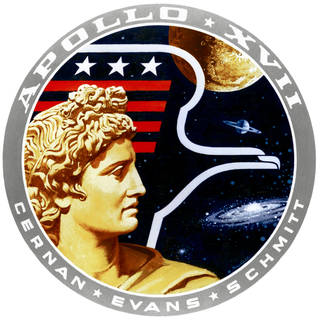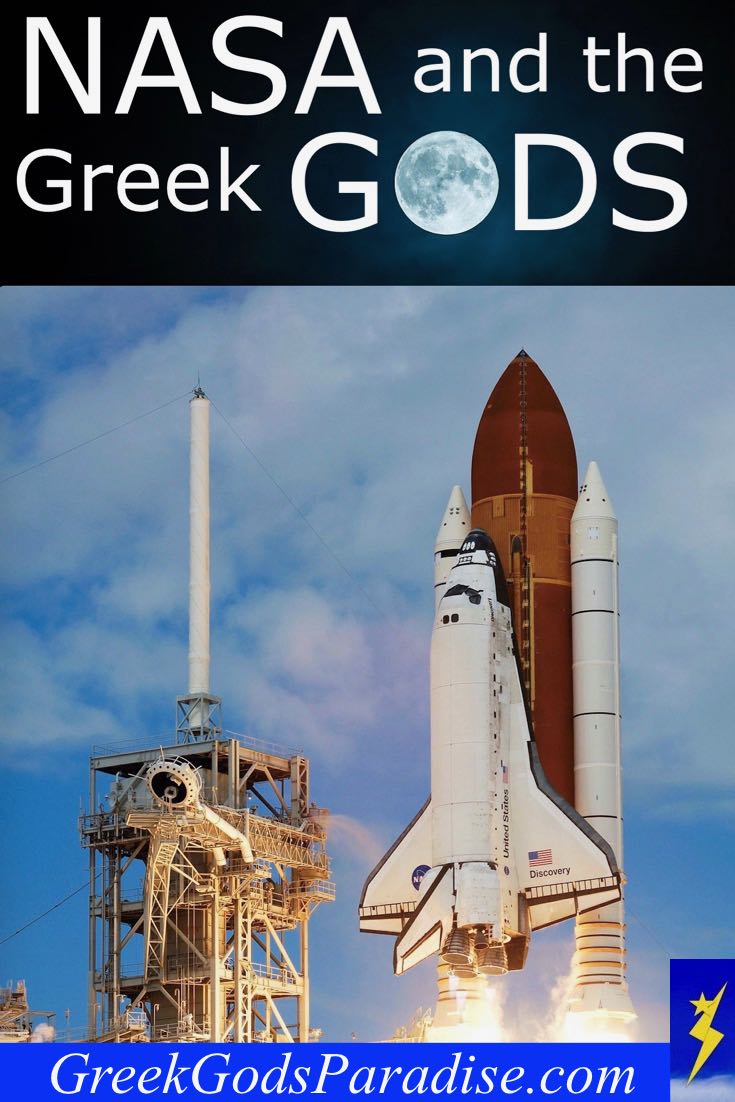NASA and the Greek Gods go way back — all the way back to the early space missions named after Mercury and Apollo.
Today, NASA still uses names and symbols based on Roman and Greek mythology.
Let’s take a look to see how the Greek Gods assisted and stalled NASA’s space program.
1958 – 1963: Project Mercury (NASA and the Greek Gods)


- The Mercury mission was the first U.S. crewed program.
- The astronauts were collectively known as the “Mercury Seven.”
- Number 7 appears in the Mercury monument above because each spacecraft was given a name ending in “7” by its pilot. As a comparison, you can see the standard Mercury symbol on the right. What looks like a circle and horns actually represents Mercury’s winged cap.
- All of the six manned Mercury flights were successful. Mercury (Hermes) is the God of travel so you’d hope so.
1963 – 1966: Gemini Program
The four main objectives of the Gemini mission were to:
- Test an astronaut’s ability including the spaceflight equipment on extended missions (up to two weeks in space).
- Practice space rendezvous and docking in space.
- Perfect re-entry and touchdown methods.
- Undertake and evaluate certain tasks which included spacewalks outside the spacecraft’s protection.
The Gemini mission was named after the constellation of The Twins, represented by Castor and Pollux, the half-twin brothers from Greek and Roman mythology.
This second mission name was quite suitable since the Gemini spacecraft only carried two astronauts.
The whole point of the Gemini program was to develop space travel techniques to support a future moon landing attempt reserved for the Greek God, Apollo.
There were ten launched crewed missions as part of the Gemini program.
1960 – 1972: Apollo Program

- Apollo brought the first humans to the Moon.
- The number of launched crewed missions: 11
- Apollo 11 landed on the moon in July 1969.
- In 1972, Apollo 17 was the last of the six Apollo missions to the moon.
How the Apollo Spacecraft works: Part 2
How the Apollo Spacecraft works: Part 3
Words (Don’t Come Easy) – 1982 Song by F. R. David
1967 – The Apollo 1 Launch Pad Accident
On January 27, 1967, astronauts Gus Grissom, Ed White, and Roger Chaffee were engulfed by smoke and flames during a routine prelaunch test of the Apollo 1 spacecraft.
While inside the cabin on the launch pad, faulty wiring sparked a fire that tore through the cabin’s pure oxygen atmosphere, which was pressurized at 16 pounds per square inch.
A pressure of 16 pounds per square inch at sea level is the equivalent of 5 pounds per square inch in space.
Fire in the cabin at five pounds per square inch would have been containable, but the higher pressure made the fire uncontrollable.
The complicated latch system on the hatch, another design flaw, made it impossible for the astronauts to escape the inferno.
The one positive that came from this tragedy is that it did lead to NASA making major design improvements for future missions.
1970s: Titan-Centaur
The Titan-Centaur launches of Viking and Voyager spacecraft were NASA’s most high-profile successes during the 1970s.
- 1974: First successful launch of a Titan-Centaur takes place.
- 1975: Titan-Centaur launches Viking 1 and 2 spacecraft to Mars in the summer.
- 1977: Titan-Centaur launches Voyager 1 and 2 on missions to explore the outer solar system.
1971 – Olympus Mons (The Biggest Volcano in the Solar System)
- On November 14, 1971, the unmanned NASA space probe Mariner 9 arrived at Mars.
- It was the first spacecraft to orbit another planet.
- Pictures from Mariner 9 revealed that Nix Olympica (thought to be the highest point on Mars via telescope) was not just a big mountain, but a massive volcano on Mars that dominated an area 600 km (370 miles) wide.
- The name was soon changed from Nix Olympica to Olympus Mons (which means Mount Olympus, since Mons is the Latin term for “Mountain”).
- Olympus Mons is nearly around 2.5 times the height of Mount Everest above sea level and has a total elevation of about 26 km (16 miles) high.
1989: Olympus-1 Satellite launched
- On July 12, 1989, the European Space Agency launched the largest civilian telecommunication satellite ever built.
- In 1991, it malfunctioned and was lost in orbital space for a year before communication was re-established.
- In 1993, it was damaged during the height of the Perseid meteor shower and was decommissioned for good.
1990 – 2009: Ulysses observes the Sun
Ulysses (Odysseus in Greek) was a robotic space probe launched by NASA whose primary mission was to orbit the Sun and study it.
- The Sun is the most massive and largest object in our solar system.
- It is approximately 330,000 times greater than the Earth’s mass.
- The diameter of the Sun is 109 times as great as the Earth’s diameter.
- It is made up of almost three-quarters Hydrogen. The remaining part is mostly made of Helium.
2001 – Mythodia (Mars)
On 28 June 2001, Vangelis Papathanasiou, a famous Greek musician, gave a unique musical show called ‘Mythodia’ in Athens.
This show was sponsored by NASA, at the same time when one of its spacecraft had entered the orbit of Mars.
Rumors at the time speculated that the entire concert offered a message to the Greek Gods, as the concert presented the history of Hellenism and ancient Greece.
MYTHODEA was supposedly a hymn to Zeus:
2007: Themis
2009: The THEMIS mission split into two missions:
– The first, THEMIS-Low, consisting of the three inner probes (P3, P4, P5), will continue to study the Earth’s space environment.
– The two outer probes, P1 and P2, were to explore the space environment of the moon. This new mission was renamed ARTEMIS (Acceleration Reconnection Turbulence, and Electrodynamics of Moon Interaction with the Sun).
2010: “Ares I” and “Ares V” were the names of rockets that launched the space shuttle’s successor to the Moon and Mars.
2011 – 2015: Messenger was a NASA robotic spacecraft that orbited the planet Mercury. The main purpose was to study Mercury’s chemical composition, geology, and magnetic field.
2011 – Juno Space Probe
In Roman and Greek mythology, Zeus (Jupiter) is the king of the Gods, and Hera (Juno) is the queen.
Their marriage wasn’t all easy sailing, mostly due to Jupiter’s uncontrollable lust/love of other beauties.
The planet Jupiter has at least 67 known moons.
Io, Europa, Ganymede, and Callisto are the largest four moons. All of them are named after a few of Jupiter’s famous mythical lovers.
These four moons are also referred to as the Galilean satellites because they were first observed by the astronomer Galileo Galilei in 1610.
- There are about 170 moons in our Solar System. Most of them are in orbit around the gas giants Jupiter and Saturn.
- Uranus has 27 known moons.
- Neptune has 14 known moons. Neptune’s largest moon is Triton. Triton is slightly smaller than Earth’s Moon and has active volcanoes which erupt like geysers.
- Mars has two very small moons named Phobos and Deimos. Both are named after the Greek mythological twin characters Phobos (panic/fear) and Deimos (terror/dread) who accompanied their father Ares, God of war, into battle.
- Earth has one Moon, whereas Mercury and Venus have no moons.
2022 – Artemis 1 Mission
The aim of the Artemis missions is to land the first woman on the moon and the first woman of color on the moon. It will be interesting to see how it turns out.
Future Space Missions
2023: NASA’s Psyche probe – NASA plans on visiting 16 Psyche (an asteroid made almost entirely of nickel-iron metal). Must have something to do with Eros, the God of Love.
Pin it … Share it






